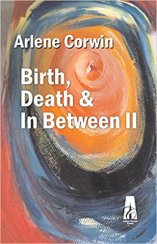
Birth, Death, & in-Between by Arlene Corwin
Having composed 3,000 poems, Arlene Corwin has extended the thematically based book Birth, Death & In Between II, the theme repeating it seems, lifelong – repeated, but never repetitive. She speaks of the worlds of thought and event which start in birth and end in death. Corwin has opinions, universal and far-reaching, and throughout her world of Art all encompassing ; mature in breadth and style as well as years. A prolific writer, she goes from the ridiculous to the sublime, creating phantasmagorical ideas and working them until they have the rhythm, rhyme and development that satisfies her. She says she has no plan, aim or scheme to help her. A jazz musician and longtime yogini, she pu
Amazon USAReview by Mary Barnet
Author: Arlene Corwin
Binding: Paperback
ISBN: 9789386653307
Publisher: Cyberwit.net Pub. Date: 2017 Price: $15
BUY NOW FROM AMAZON UK AMAZON USA CYBERWIT
Having composed 3,000 poems, Arlene Corwin has extended the thematically based book Birth, Death & In Between II, the theme repeating it seems, lifelong – repeated, but never repetitive. She speaks of the worlds of thought and event which start in birth and end in death. Corwin has opinions, universal and far-reaching, and throughout her world of Art all encompassing ; mature in breadth and style as well as years. A prolific writer, she goes from the ridiculous to the sublime, creating phantasmagorical ideas and working them until they have the rhythm, rhyme and development that satisfies her. She says she has no plan, aim or scheme to help her. A jazz musician and longtime yogini, she puts the thought in a free-flow verse and then though the evolution from free flow it develops into Arlene’s wonderful poetry. Corwin trusts the improvisatory.
As a musically gifted child, she studied harp, piano and voice. So Corwin made music her profession, jazz her genre. She graduated from the High School of Music & Art in New York City and Hofstra University. She published her first book in 2010 and has published her fine poetry regularly since then. Born in 1934 in Brooklyn, New York, Corwin has spent the last 34 years playing, singing and writing in Sweden.
In Arlene Corwin’s book, “Birth, Death and In Between II”, she takes on an age-old question : what is Death and how do we experience its imminent arrival ? Corwin shares this experience with the reader, a question, less anxiety bearing, when spoken with words with which we can feel comfortable. In the poem How Did Shakespeare Die?, her 16th book Birth, Death & In Between II, Arlene Corwin speaks of times past in her inimitable manner. She reveals the interpretation of a genius of the past with those of others past and present and finds all of us equal. Facing Death she declares us all the same.
On page 55, we find the poem Intimations Of Immortality. It is quite lyrical and she sees herself thusly :
I, whose custom is to ‘call a spade a spade’,
Dare say the word mortality,
For it is death I sense, come closer daily
She finds for herself reaching into her jazz background and her great performances and fellow musicians and successful composition of music to find herself in the company of the immortality of the artist and with Wordsworth as a companion :
Yet we have a bond, Wordsworth and I,
For hopeful of a kernel die
That cannot die, but timeless,
Never was and is always,
I wish to look on heart that’s inner,
Atoms of the saint and sinner
Coming back re-formed and re-acquiring
Shape and name:
A game of soul rebirth eternal,
Hints of strange forever-ness,
Its paradox forever mortal,
Yet immortal.
Corwin reaches her own Life in the following poem (page 168) which sums up Arlene Corwin’s personal thoughts about her approaching Death.
Why Am I Afraid To Die?
Why am I afraid to die?
I’ll lose my I, that’s why!
Miss my my!
It’s all about the ego, which
Defined,
Means me in mind.
And that’s worth the examining!
So, how to do it?
Why not just say, “Screw it, for
It’s not important?”
Well, it’s inner pain, the seed of fear.
What is there to miss?
Belongings? Passing piss.
Family, friends? A wilderness!
We think that we’re in sync’
With lives and destinies.
Realities are singular: theirs, yours.
It’s all illusory.
The things you own are goin’, –
When, you can’t foresee.
You’ve no authority.
Next, there is the fear of disappearing.
Consciousness without a hope of bliss
Or at the very least some happiness –
Not there – forever: me, my, I dissolved to atoms;
Nothing but a flotsam, jetsam,
Maybe some becoming stardom;
We can all find comfort, like Dante, finding kindred souls in our aftermath. Corwin, like Virgil, shares the mortality of the past through her assessments of other mortals, and their struggle with finite life.
Further, it is very difficult to add anything to her poem Why Am I Rushing It? as it yields the following wisdom :
“Who am I kidding?
Just exactly where one is
Is just exactly where one’s meant to be.”
“Abandon…hope…’said Dante, for
We are not free. We’ve no control.
“Nope!” say we, and stay afraid.
Ego should be renamed let-go,
Letting-go from now or here.
So why am I afraid to leave this joint?
There is no point.”
I recommend you read Arlene Corwin’s book !
In the final poem of the book Arlene closes with sardonic humor:
Z =The Most Ridiculous Of All
The most ridiculous of all –
Let’s see,
What can it be?
Death. Yes, death.
It’s farcical,
The disappearing
A distortion
Of the reason for
Our
Being here .
By Mary Barnet
86 Sonnets for the 21st Century (Casa de Snapdragon, 2015) ; The New American : Selected Poems (Cyberwit, 2006) ; Arrival (Casa de Snapdragon)
Editor-in-Chief for 20 years of PoetryMagazine.com
Copyright 2017, Mary Barnet
All Rights Reserved.
